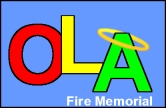
| Our Lady of the Angels (OLA) School Fire, December 1, 1958 |
|
4650 N. Rockwell St. Chicago, IL 60625 |

|
Phone: 773/583-7800 Fax: 773/583-7877 |
Great Chicago Fires:
Historic Blazes That Shaped a City
By David Cowan

And call for the wagon to come and take her home.
Her mother will cry some and so will her sisters and brothers.
But all of the others got down and they are safe and this is the
It is the hand of God and the lack of fire escapes.
When compared to the ancient cities of the world, Chicago's history is
short, almost embryonic. But in no way is it any less violent. Murder and
mayhem had visited Chicago long before the advent of the Tommy gun. And so too had
fire.
The word "fire" can trace its origin to the Greek words pyr and pur, which, according to most interpretations, mean "to purify." If this is the case, then surely the United States must rank among the world's most purified countries and Chicago its most purified city. As such, no history of Chicago can be complete without discussing the effects fire has had on the city, effects that have both been revolutionary and disastrous.
Firefighters often speak of fire as a living entity with a deliberate and sometimes cunning mind. Looking at the history of Chicago, we might believe it also to be an intelligent force, one whose flames have burned the city's wastes, mistakes, and embarrassments. Many volumes have been written about the Great Chicago Fire of 1871, a conflagration that stunned the city and the nation and forever welded Chicago and fire in the mind of the world. But the history of fire in Chicago doesn’t begin or end in October 1871. In fact, when the "I Will" city emerged from the ashes of the Great Fire, it was following the example of an earlier Chicago, when the garrisons and entrepreneurs returned in 1816 to rebuild Fort Dearborn after it had been burned and its people massacred by the Potawa-tomi. Just as this, Chicago’s first fire, illumined the faces of settlers determined but ill-prepared to face the uncertainties of the prairie, so too would future fires highlight the failings and frailties of an evolving modern city.
As the millennium turns, fire continues its role in Chicago's progress and change, lighting up a past culture: the factories, the warehouses, the multitude of ghetto flats of the "city that works" gone on to other things. Chicago is still burgeoning, but in different ways. Thus the story of Chicago and fire is a tale of the will and the courage to face shortcomings and consequences with a determination to reform, rebuild, and reinvent.
This book chronicles Chicago’s other great fires, some of them headline
makers, others not so famous, all of them valuable in the lessons they
brought in the fields of fire safety and engineering, albeit at the
expense of hundreds of innocent lives. A few common denominators found in most
multi-fatality fires include overcrowding, inadequate exits, and lack
of proper fixed fire protection. These factors were present in 1903, when
602 people, mostly women and children, died in the Iroquois Theater fire;
and again in 1958, when a fire at Our Lady of the Angels school left 92
students and three nuns dead. These terrible tragedies brought to light
deplorable public safety conditions and their worst potential, forcing the nation
to assume its responsibility for improvement. Perhaps it can be said that
in this sense the victims claimed by these and other fires did not die in
vain, that their deaths helped make today’s world much safer.
| Back | Top of Page | Home |